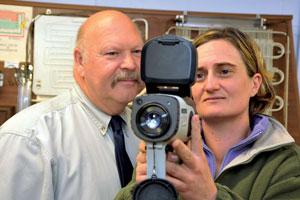|
“A DISTINCT lack of technical training in the field of thermography could be costing With over 30 years experience in infrared thermography, Canadian-based Ruddock was in town to deliver his Level 1 Infrared Thermography Certification programme to a varied group of professionals from the paper and pulp, water and equine industries. Director of Advanced Infrared Resources, Ruddock has gained an international reputation in thermography and has travelled extensively to Australasia, North America, “Without being properly trained, technicians can report unreliable, false temperatures and recommendations. This can result in unnecessary equipment shutdowns and failure to detect potential problems that could lead to catastrophic failures.” And it’s this misunderstanding and lack of training that Ruddock claims could lead to thermography gaining a bad reputation in industry for being inaccurate and producing false results. These issues are compounded by the fact that the price of infrared cameras has dramatically dropped, meaning more companies can afford to invest in them. Yet, it seems that investments in equipment are not being backed by sufficient thermography training. During his career Ruddock has witnessed some serious misuse of thermography equipment. “Many people make the mistake of thinking that an infrared device measures temperature,” says Ruddock. “In actual fact, infrared radiometers, whether they are a simple handheld radiometer or a $100,000 precise imaging radio- Ruddock is quick to point out the benefits of thermography, not just for industry but also as a tool to help us find solutions in all walks of life. As one of the fastest growing forms of non-destructive testing in the world, infrared thermography is now recognised as an essential maintenance tool in many disciplines including mechanical and electrical engineering and process inspections. organisation. Doing things this way round could help you prevent costly mistakes in the long-run.” |
“With the correct training and knowledge infrared thermography has the potential to be an effective predictive maintenance tool,” adds Ruddock. “Advances in the technology mean that potential problems which are unseen by the naked eye can be detected at an early stage and corrective action taken before costly system failures cause major disruption. “With a well designed infrared programme companies can graduate from predictive to proactive maintenance practises.” Larry Wiechern, senior lecturer in Manukau Institute of Technology’s Maintenance and Reliability Centre echoes Ruddock’s views. “Many companies make the mistake of thinking their investment ends with purchasing the equipment,” says Wiechern. “But put these devices in the wrong hands, with no supporting training and the result could be disastrous. At MIT we recognise the benefits thermography can provide when used in conjunction with other maintenance diagnostic tools and that’s why we cover the subject in a wide range of our programmes and seminars.” Ruddock’s advice to companies considering purchasing thermography equipment is to firstly think about training. “Before buying the infrared device you should invest in some thermography training,” he says. “This will help you to not only understand what equipment to purchase to suit your needs but also to really get to grips with the technology and ensure it is applicable to your organisation. Doing things this way round could help you prevent costly mistakes in the long-run. Email: donna.davies@manukau.ac.nz |






